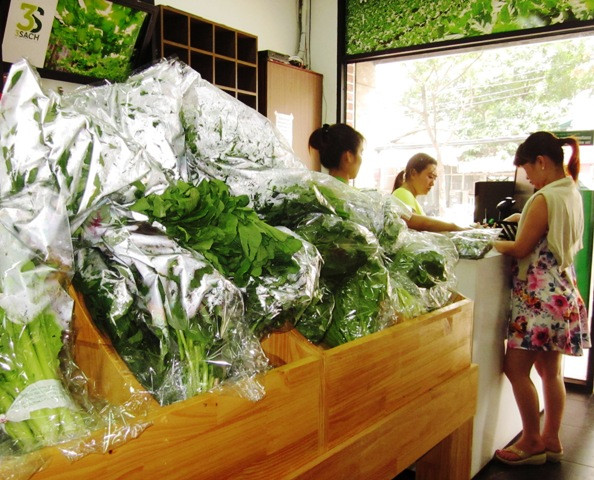Clean food business everywhere
Understanding the confusion of consumers after the news of food containing chemicals, many small businesses have immediately applied the clean food business model to attract customers.
These days, clean food stores and stalls appear quite a lot on the streets, markets in Ho Chi Minh City and even on the internet community. Recently, on Nguyen Dinh Chieu Street (District 3), a 3 clean food store appeared. According to the staff here, 3 clean means clean growing, cleaning and selling clean. All chicken and pork are raised on farms in Cu Chi district, and vegetables are taken from farms of farmers with VietGAP certification. Therefore, meat, fish and vegetables here are often 10,000-30,000 VND more expensive than in the market.
“The prices here are at least 20% higher than in the market or supermarket, but the important thing is that the vegetables and fruits are grown safely, without using toxic chemicals and have clear certificates,” said an employee here.

More and more places are selling clean food. Photo: Hong Chau.
Having only been open for a few months, the store is quite crowded with customers, 50-100 customers per day, not to mention 20-30 home delivery orders. Many first-time customers come back for a second time, some of them order millions of VND to use for the whole week.
Although they do not open a store like above but only accept orders and deliver to their homes, Ms. Van (District 1) and Ms. Thuy (Binh Thanh District) are also increasingly increasing their income from selling clean pork and seafood.
Based on their own needs, but after a period of sharing information that many people were interested in about clean food, the sisters came up with a business idea. Most of the food that Ms. Van and Thuy provide is taken from the countryside and only sold one day a week. Ms. Van said that normally, her younger sister will buy pigs in the village, then find a quarantine facility to check the quality before slaughtering. One week, she only delivers goods on Sunday mornings. Therefore, on Saturday afternoon, the pigs will be slaughtered and sent to the South that same evening, arriving in Ho Chi Minh City at 5am the next morning. After dividing and fully packaging, she hires someone to deliver them that same morning.
As for Ms. Thuy, after counting the number of orders, she immediately sent the information to her younger brother in Ca Mau. Usually, every Friday afternoon, her younger brother would go to the boat to collect the goods and send them to her in the evening. By 4am on Saturday, the goods had arrived. Then, she hired someone to clean and pack them early in the morning. After packing, she delivered the goods to everyone in the morning. Thanks to the above factors, their customer base has increased rapidly, initially only over 100 customers but now there are about 200-400 customers.
Not only clean meat and seafood are in high demand, but clean beans are also increasingly popular. The bean curd shop, in a small alley on D2 Street (Binh Thanh District) near the old Van Thanh Market, is always packed with customers. Mr. Hung, the owner of the bean curd shop, said that to make delicious, clean beans that do not contain gypsum, he has to choose good beans, soak them thoroughly in cold water, clean the shells, wash them many times with clean water and cook them according to the correct process without adding any chemicals. He sells them as soon as he makes them, so his beans are always hot and delicious.
He gave a way to identify “clean beans” as soft, creamy beans. For newly baked white beans, they are usually golden in color, but when cooled, they will turn white. For fried tofu, the tofu must be puffed up, but if it is not puffed up but hard, the tofu has chemicals and has been fried many times. “Because of the principle of putting cleanliness first, I sell about 1,000 pieces of tofu and 100 liters of soy milk a day. Sometimes I cannot serve customers in time, so I have to hire more workers,” said Mr. Hung.
In addition to shops and markets that follow this trend, now restaurants also put up "clean food" signs.
“Two years ago, I sold clean food sourced from Hoi An but did not put up a sign saying “clean food”. In recent months, there has been a lot of information about chemical food causing confusion for consumers, so to differentiate, I had to put up a sign to match the times”, said Mr. Hung, owner of a drinking place on Ba Huyen Thanh Quan Street (District 3).
Mr. Hung also admitted that since hanging the "clean food" sign, the number of customers has increased significantly. Previously, instead of only 30 customers coming to eat, now it has increased to 50-60. In the future, customers will eat well and feel secure, so the number of customers will increase, Mr. Hung believes.
Evaluating the above business forms, the leader of the market management agency said that this model also has good business units that need to be promoted. However, there are also exceptional cases, taking advantage of posting advertising signs to attract customers. Therefore, in order not to waste money, consumers need to be careful in choosing food from units that are registered, have full food quality certificates, and have clear information about the origin. "As for units that choose to post "clean food" signs to promote, after just one contact, consumers can easily recognize and boycott immediately," said the above leader.
He added that in the coming time, the City Market Management Department will propose that relevant departments coordinate to inspect these types of businesses to see if the quality is really as advertised.
According to vnexpress-PH






